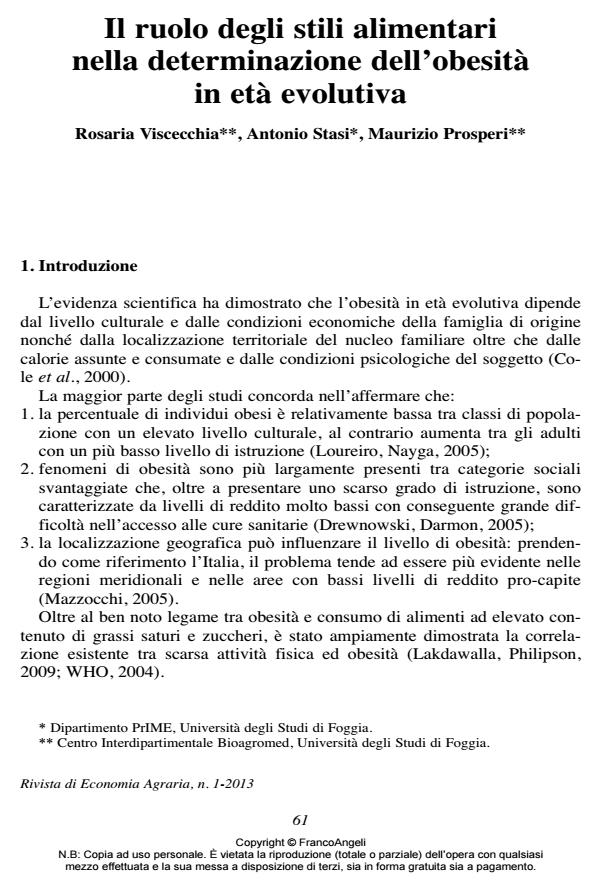Obesity in teenagers: the role of eating habits
Journal title RIVISTA DI ECONOMIA AGRARIA
Author/s Rosaria Viscecchia, Antonio Stasi, Mauizio Prosperi
Publishing Year 2013 Issue 2013/1
Language Italian Pages 16 P. 61-76 File size 373 KB
DOI 10.3280/REA2013-001004
DOI is like a bar code for intellectual property: to have more infomation
click here
Below, you can see the article first page
If you want to buy this article in PDF format, you can do it, following the instructions to buy download credits

FrancoAngeli is member of Publishers International Linking Association, Inc (PILA), a not-for-profit association which run the CrossRef service enabling links to and from online scholarly content.
Obesity is one of Europe’s most serious public health challenges. The prevalence of obesity and overweight is reaching considerable levels especially in the South of Italy. There is a large body of literature about the determinants of obesity and political tools for its prevention and reduction. This paper aims to analyse the obesity phenomenon through the study of teenagers’ eating habits. Unhealthy lifestyles, in particular alcohol, snack and junk food are investigated. The study is based on a case study referred to a population of 900 students (age 11-19) in the city of Foggia. Results of cluster analysis show three segments Sedentary people (47%), Dynamic people (26%) and Moderate people (27%); results of regression show that BMI increases in each cluster for different causes and the effect of the same food product is different for the three segments. These results suggest that an integrated approach of marketing and public health may have a positive impact on the prevention of obesity and overweight.
L’incidenza dell’obesità e del sovrappeso ha raggiungo livelli estremamente rilevanti soprattutto nei bambini e negli individui in età evolutiva. La letteratura fornisce diverse indicazioni su quali possano essere le variabili sensibili che permettano di mettere a punto politiche mirate alla sua riduzione. Ciononostante, il presente lavoro si propone di andare più a fondo nell’esplorazione del problema attraverso l’analisi degli stili alimentari, che nei teenager possono essere molto diversi rispetto agli adulti, delle deviazioni come consumo di alcol e spuntini fuori pasto, e dello stato psicofisico che in questo studio ipotizziamo sia concausa dell’incremento del BMI. Il presente lavoro è basato su dati riguardanti 900 individui dell’area di Foggia. I risultati consentono di profilare tre stili alimentari e l’analisi di regressione permette di evidenziare diverse cause di incremento del BMI per ciascun gruppo individuato. I risultati sembrerebbero avvalorare l’ipotesi secondo cui le cause di sovrappeso e obesità risultano differenti per individui appartenenti a diversi stili alimentari.
Keywords: Obesity, eating habits, teenager, cluster
Jel codes: I18, Q18
Rosaria Viscecchia, Antonio Stasi, Mauizio Prosperi, Il ruolo degli stili alimentari nella determinazione dell’obesità in età evolutiva in "RIVISTA DI ECONOMIA AGRARIA" 1/2013, pp 61-76, DOI: 10.3280/REA2013-001004